Perhaps you have heard about Google’s E-E-A-T guidelines and are wondering what they mean for your WordPress website.
Google’s search algorithm and guidelines are constantly changing and evolving to make sure that search engine results pages (SERPs) prioritize quality content that’s helpful and accurate. Although E-E-A-T is not a direct ranking factor, Google wants to serve results with strong E-E-A-T.
In this article, I’ll explain what E-E-A-T is all about and how you can implement it on your website.
Note: This is a guest post by Benjamin Rojas, the president of All in One SEO, the best WordPress SEO plugin on the market. This is an expert column that we publish every other Thursday, where we invite a WordPress expert to share their experiences with our readers.

What Is E-E-A-T?
E-E-A-T stands for Expertise, Experience, Authoritativeness, and Trustworthiness.
These are four overlapping factors they look for when looking for reliable and trustworthy sources of information to rank near the top of search engine results pages.

The ‘Experience’ factor in E-E-A-T was introduced in a Google update in 2022. Before that, it was simply known as E-A-T.
Here’s how each factor contributes:
- Expertise lets a writer demonstrate a deep understanding of a topic, such as when they have training or qualifications in the field.
- Experience allows an author to write content based on first-hand experience, allowing them to provide more accurate and helpful information.
- Authoritativeness is when a writer is respected by recognized experts in the field or writes for a website that has a strong reputation for reliability.
- Trustworthiness comes from unbiased and objective content found on a website that is transparent about its sources and funding and concerned about the safety and security of its readers.
To satisfy the E-E-A-T principle, you need to add these factors to your WordPress website.
Note that E-E-A-T is not the only consideration. To ensure your website ranks well, you need to develop a comprehensive SEO strategy.
How Does Google E-E-A-T Affect SEO?
It’s easy to spread misinformation written by people who don’t have any expertise or experience with the topics they are writing about, which makes content you discover on the web less-trust worthy.
That’s why Google has implemented E-E-A-T guidelines. Google doesn’t want to promote misinformation to its users. So they use the E-E-A-T principle to assess whether a webpage can be considered a reliable and trustworthy source of information.
This is particularly important when misinformation can affect the reader’s health, safety, happiness, or financial security. This is what Google calls YMYL.
What Is YMYL?
YMYL stands for ‘Your Money or Your Life.’ This is Google’s term for describing the types of topics where misinformation has the most serious consequences, such as finance and health.
This includes topics such as:
- Health and wellness, such as medical and health sites that offer health advice, medical information, content about drugs, fitness routines, and more.
- Finance and money, including finance sites that offer advice, investment information, advice on tax law, and similar.
- News and current events sites that report on news and international events, science and politics, natural disasters and emergency preparedness, and more.
- Government and law websites that inform people about legal issues, official rulings, voting, social services, and related topics.
- Shopping and e-commerce sites that offer product reviews and comparisons and offer products for sale.
If your website covers topics like these, then you need to minimize the risk of harm your content presents so users can trust the information you provide.
Also, be aware that Google will be even more careful to make sure that your content is accurate and reliable, so it is essential that you demonstrate E-E-A-T on websites that fall into the YMYL category.
How Does E-E-A-T Help SEO?
E-E-A-T isn’t an official ranking factor. That means that it doesn’t impact your site’s SEO directly.
Instead, it is part of Google’s Search Quality Evaluator Guidelines. This is a 168-page PDF manual for Quality Raters. This is a worldwide team of people who evaluate the quality of search results and give Google feedback so they can improve their algorithms.
These factors, including E-E-A-T, can help boost your SEO indirectly.
So strong E-E-A-T signals can contribute to your website being ranked higher in queries. This is especially true for high-competition keywords that are about YMYL topics.
Levels of E-E-A-T
Unfortunately, there is no way to measure the E-E-A-T score for your website.
However, Google’s guidelines give a clear idea of what websites with different levels of E-E-A-T look like:
- Websites with very high E-E-A-T contain high-quality articles that show evidence of topic knowledge and expertise. These authors and websites are the most trusted sources on the internet for a particular topic.
- Websites with a high level of E-E-A-T offer content that displays first-hand experience and expertise on a topic. These pages are considered trustworthy or very trustworthy.
- Web pages that lack appropriate E-E-A-T may have a good reputation in other ways, but lack experience in the topic they are about. This could be a reputable cooking website with an article on tax, or someone reviewing a restaurant they had never visited.
- Websites with the lowest E-E-A-T will look and feel spammy and offer a poor user experience. The main content may be obstructed and it may contain malicious downloads.
You should aim to have a high level of E-E-A-T on your website, and this will take time.
With that being said, here are some tips on how you can meet Google’s E-E-A-T content guidelines to give your WordPress site’s SEO a big boost:
- Create High-Quality Content That Is Helpful and Informative
- Continue to Write Fresh Website Content
- Address Knowledge Gaps in Your Content
- Keep Your Content Up to Date
- Talk About First-Hand Experiences in Your Content
- Manage Your Website’s Online Reputation
- 7. Showcase the Experience & Expertise of Your Business and Team
- 8. Showcase the Experience & Expertise of Individual Authors
- Boost Author SEO Using All in One SEO
- Claim Your Google Knowledge Panel
- Earn Recognition From Other Experts
- Have Experts Review Your Website Content
- Build Trust by Building Authoritative Backlinks
- Look After Your Site’s Technical SEO
1. Create High-Quality Content That Is Helpful and Informative
Google’s E-E-A-T guidelines are there to encourage web content that is helpful, accurate, and relevant. Your starting point is to create that type of information.
That means that the original content you write should aim to help people rather than influence search engines. It should answer their questions, provide useful advice, and satisfy their needs.
You can achieve that by ensuring your content is accurate, well-researched, and written by experts or individuals with proven knowledge.
It should be well-structured and follow best practices for writing blog posts.
For example, you should introduce the topic in a clear way, break up your content with headings, and add images and videos to engage with your users.
Make sure you write comprehensive, in-depth articles on topics that are central to your industry or niche. This cornerstone content can help you establish your authority on those topics and build your reputation in the industry.
2. Continue to Write Fresh Website Content
Experts don’t run out of things to say. Instead, they continue to have fresh experiences where they glean insights they can write about.
By adding new content to your website, you demonstrate to Google that your website is alive and well-maintained. It also shows that you are continuing to learn, grow in expertise, and gain new experiences.
It’s a good idea to brainstorm new content ideas on a regular basis and plan your editorial calendar ahead of time. You can get new content ideas using online blog post idea generators and checking out your competition’s websites.
Also, when you perform a Google search, other relevant topics that you can write about will be suggested. You may also see a ‘People also ask’ section on the search results page that shows related questions that people want answers to.
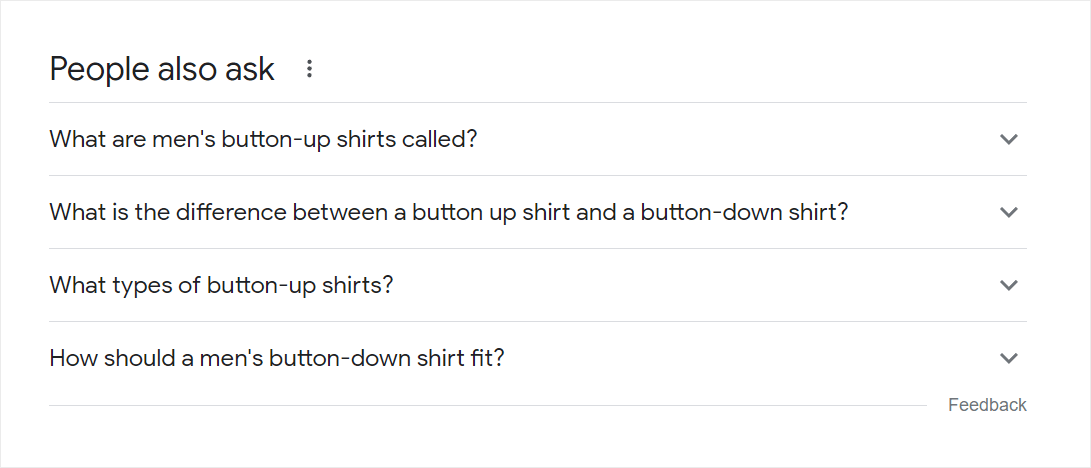
3. Address Knowledge Gaps in Your Content
One important aspect of planning new content for your website is identifying knowledge gaps. These are topics that your audience is looking for, but you (and perhaps your competitors) haven’t covered them yet.
Filling a knowledge gap and bringing something new to the table is an effective way to demonstrate E-E-A-T. It could be new information that hasn’t been covered or a new perspective based on your own unique experience.
To do this, you will need to perform a content gap analysis.
For example, you can use Semrush’s Keyword Gap tool to discover keywords that your competitors are ranking for but you are not. This will provide a list of seed keywords you can use to create content ideas.

Next, you will need to optimize your existing blog posts to fill those gaps or add new articles that cover those topics to your content calendar.
4. Keep Your Content Up to Date
Things change. Content that was accurate and helpful in the past won’t always stay that way. Over time, these articles will become less relevant and attract less traffic. This is known as content decay.
You should regularly review your articles and update any information that is out of date and no longer accurate. It’s a good idea to check and update each article on a regular schedule, such as every 6 months.
You can find decayed content that needs to be updated using SEO tools such as All in One SEO. You need to identify posts with a significant drop in traffic.
For example, the Content Performance report in All in One SEO can identify the top losing posts in terms of content performance.
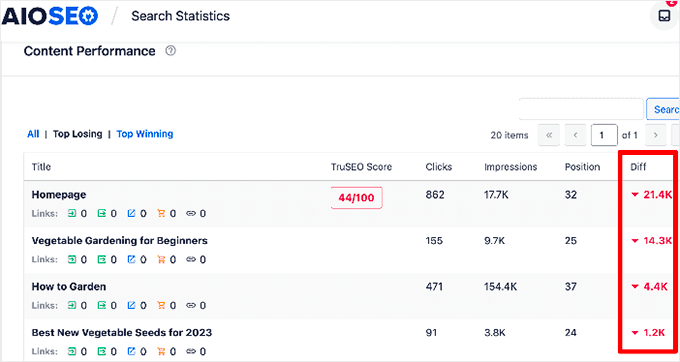
You can now use AIOSEO’s built-in SEO recommendations to optimize your decaying content to boost your rankings again.
5. Talk About First-Hand Experiences in Your Content
You should demonstrate that the content comes from personal experience rather than internet research. This means talking about your unique, first-person experiences in your posts.
For example, if you are reviewing a restaurant, you should talk about your visit, describe the service you received, and let your readers know how the meal tasted.
Google will pick up on phrases like these as signals that you have personal experience:
- In my experience…
- In our tests…
- When we tried…
- We found that…
If you tested a product, you should include the measurements and statistics of your tests. You can also talk about subjective assessments based on your use of the product, such as what it felt like to use, whether you enjoyed it, and specific ways you found it helpful.
Also, make sure you use first-person pronouns like ‘I’ or ‘we’ rather than ‘she’ or ‘they’ to demonstrate that you are talking about your own experience and expertise, not someone else’s.
Finally, it is best to use original screenshots and images in your posts, such as a photo of the equipment you are using, or the end result of a tutorial you are writing. Google tends to reward originality, and it’s another way to demonstrate your personal experience
6. Manage Your Website’s Online Reputation
A brand with a negative reputation lacks credibility.
Building a positive brand begins with creating a quality website that you own and control. It allows you to build trust, market yourself, and manage your online reputation.
You can make sure your visitors remember your brand by creating a logo that is clear, relevant, and displayed in the header. You can also choose a matching color scheme to boost your website’s appeal.
However, managing your reputation goes beyond your own site to social networks and review platforms. You need to monitor social platforms for negative mentions or reviews and respond in a prompt and professional way.
You can also display positive reviews and testimonials on your website. Tools like Smash Balloon Reviews Feed Pro will find and filter testimonials from multiple review platforms and automatically display them on your site.

7. Showcase the Experience & Expertise of Your Business and Team
There’s no better way to demonstrate your experience and expertise than to state it clearly. Be specific and accurate as you highlight your qualifications, experience, and achievements in your industry or field, and don’t misrepresent yourself.
Many websites do this on an About page or Team page.
An About page tells visitors about the purpose of your website and business, as well as its mission and values. It lets them know what they can expect on your site, and being transparent about who you are will build trust.
If you have a multi-author website, then you could use a Team page instead. Here you can list the names of your writers along with their qualifications and experience. Make sure you include photos of each team member, or perhaps a single photo of the entire team.

You should include a contact form on this page or a separate Contact page, along with icons that link to your social media profiles. Visitors will be able to trust you more easily if they can see it is easy to contact you to ask questions or verify the information on your site.
Make sure that you include these pages in your site’s navigation menu so they are easy to find.
8. Showcase the Experience & Expertise of Individual Authors
You can also improve E-E-A-T on your website by showcasing the experience and expertise your authors have in their profiles. Introducing your readers to the people who wrote each post can help build credibility.
You can add E-E-A-T signals such as education, job title, employer, categories of expertise, and more. This will make it easier for Google and other search engines to identify your credentials.
This information can be automatically displayed on the posts they write using an author info box. Your visitors can then see their qualifications without needing to visit your About page.
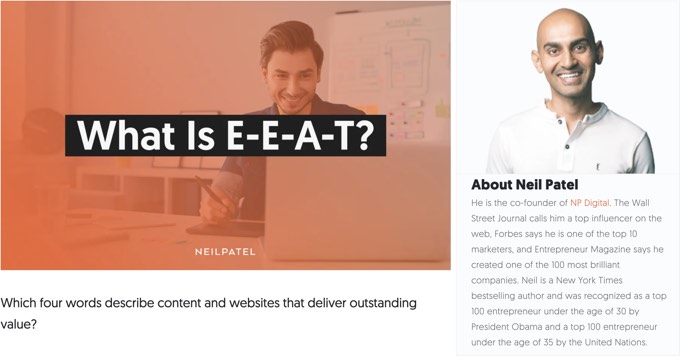
There are plenty of author bio box plugins that can be used to enhance the profiles of your team members, and many of them are free.
9. Boost Author SEO Using All in One SEO
The quickest way to start demonstrating the experience and expertise of your authors is by using All in One SEO’s powerful Author SEO addon.
This is specifically designed to improve E-E-A-T by adding important signals such as education, employer, and job title to your author bios.
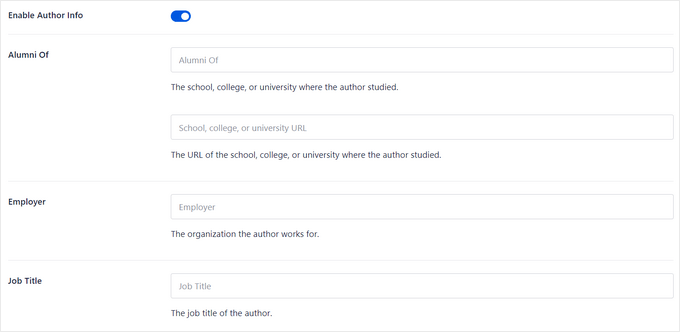
You can also add areas of expertise, which lets search engines and readers know that you’re knowledgeable about the topics you write about.
All of this author information is added as schema markup that makes it easy for search engines to find and understand when ranking your content.
You can also display the information to your website visitors using its built-in author blocks.
10. Claim Your Google Knowledge Panel
When looking at search results, you will sometimes see a panel on the right of the screen displaying information about a company, person, or product. This is a Google knowledge panel.
Here’s an example of a Google knowledge panel for the tech company Apple. It shows the company’s logo and website, information taken from Wikipedia, a list of related products, and much more.
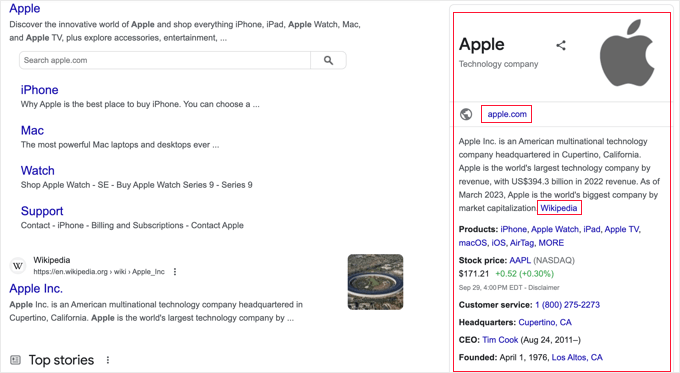
Knowledge panels may also display author and business information from your website if you added it using schema markup, such as when using All in One SEO’s Author SEO addon mentioned earlier.
Knowledge panels stand out in search results and bring more traffic to your site. They are also good for brand visibility and show users that Google finds your website credible and trustworthy.
If you are signed in to a Google account related to your business, then Google will display a button that lets you claim your business’s knowledge panel and verify that it belongs to you. This lets you choose a featured image for the panel and suggest edits to Google.
11. Earn Recognition From Other Experts
E-E-A-T signals don’t just come from the experience and qualifications of your team members. You can also earn recognition from other experts from outside of your team.
The easiest way to do that is to add citations from recognized industry experts to your content. You can link to official studies, research papers, and even tweets and blog posts by experts.
This is especially helpful for validating the accuracy of your content when you touch on topics outside of your team’s expertise. It demonstrates to Google and your readers that you place genuine value on accuracy and care enough to check your facts.
Another strategy is to invite an expert to write a guest post on your blog or ask if you can interview them and publish the interview on your blog.
12. Have Experts Review Your Website Content
Another way to establish credibility and ensure accuracy is to have experts review your content. This strengthens your E-E-A-T signals by showing that your content has been fact-checked.
You can use All in One SEO’s Author SEO addon to add a reviewer to your articles.
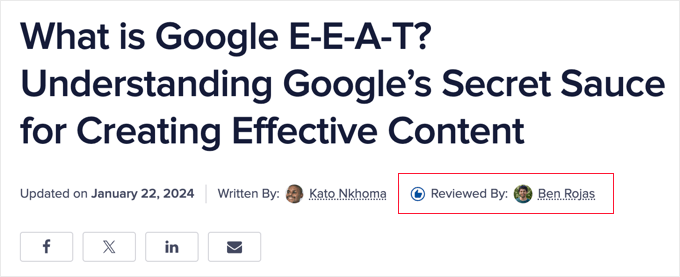
This is an important way to boost E-E-A-T for YMYL articles where you need to demonstrate that your content is accurate and up-to-date.
13. Build Trust by Building Authoritative Backlinks
Backlinks are an essential element in creating E-E-A-T content because they demonstrate that others find your content valuable and helpful.
These are links from other websites back to your own. When a website with high authority links to your content, it is seen as a vote of confidence that you are an expert in your field.
The more backlinks to one of your posts, the more authoritative it becomes.
You can grow the number of backlinks to your site by writing quality content that people want to share with their friends and clients, and by building relationships with influencers and other website owners in your industry.
14. Look After Your Site’s Technical SEO
Google won’t find your website trustworthy if your technical SEO isn’t on point. These are technical areas of your website that ensure it is safe for your visitors and customers and provide a positive user experience.
For example, if you accept payments on your website, then you need to install an SSL certificate to ensure that these transactions are secure. An insecure connection is a bad E-E-A-T signal.
The same is true of other technical issues that lead to bad user experience, such as 404 errors and failing to add alt text to your images.
To make sure that issues like this don’t affect your site’s ranking, you should conduct regular technical SEO audits.
You can find actionable steps that need to be taken using All in One SEO’s SEO audit checklist and reports in Google Search Console.
Hopefully this post helped you learn how to use Google’s E-E-A-T guidelines to improve your website’s ranking. You may also want to see our guide on how to speed up WordPress performance, or our expert pick on the best analytics solutions for WordPress users.
If you liked this article, then please subscribe to our YouTube Channel for WordPress video tutorials. You can also find us on Twitter and Facebook.





Mrteesurez
I really appreciate this guide—it’s an eye-opener! I didn’t know much about E-E-A-T before, and this article made me realize how crucial it is for any serious blogger. The introduction of terms like YMYL (‘Your Money or Your Life’) was particularly enlightening. Understanding these concepts is essential for anyone looking to build credibility and trust with their audience. Thanks, Mr. Benjamin Rojas, for this great write-up! Every blogger should read and understand this to stay ahead in the game.
Dennis Muthomi
this is valuable guide, Benjamin! this is hands down the most comprehensive guide on E-E-A-T I’ve come across. Thanks for breaking it down so clearly
Quick question – under the “Experience” part of E-E-A-T, you mentioned using first-person pronouns like “I,” “we,” and “me” when reviewing something to show Google you have first-hand experience. Do you find that really helps send those experience signals to Google? I’d love to hear your thoughts!
thanks again for this valuable resource
Jiří Vaněk
Hi Dennis,
from what I’ve read, using first-person pronouns can be a useful tool to enhance E-A-T and SEO, but it’s certainly not a miracle solution. In the context of SEO, using first-person pronouns (I or we) in reviews can indeed send signals to Google about your personal experiences with what you’re reviewing. However, it’s not a cure-all. It’s still crucial to focus on content quality, such as markup schemas, proper meta tags, and other classic SEO practices we all follow. Above all, paying attention to keywords is essential. At least that’s what I’ve read in other articles on this topic.
Moinuddin Waheed
This is one of the most comprehensive guide on E.E.A.T
I had query regarding new bloggers and websites who have just started.
how they can implement this recommendation of Google?
I mean to say that making experience and authority on a topic does take time.
and how does this E.E.A.T has impact on new blogs?
WPBeginner Support
If it is a brand new site then adding content would come first and then EEAT would be something to consider as the site and content grows. It would depend on the specific topic covered for what EEAT practices can be followed.
Admin
Moinuddin Waheed
It means that the new website owners should solely concern about creating quality content based on different keyword research that they are targetting.
once it grows enough and has enough content, Google algorithms will itself consider the website for these parameters.
Thanks for clearing this doubt.
Jiří Vaněk
I struggle with the same thing. I have a blog that is about a year and a half old and I am slowly building some reputation for it. In the beginning, Google didn’t give me many chances, but gradually it’s getting better. What really improves rankings a lot in my opinion are backlinks. Write to several bloggers with similar topics, exchange backlinks or write guest articles.
Jiří Vaněk
I would like to thank Mr. Benjamin Rojas for sharing his experiences not only in the field of SEO. E-E-A-T is a novelty for me, and I am glad I could read more information about it. SEO and the presentation of my website are crucial for me, as just a year and a half ago, when my website started, I was writing for about 2 people a day, which was frustrating for me. Thanks to wpbeginner and thanks to AIO SEO, I now have nearly 200 visitors a day. Yes, it’s not much, but my website is still relatively new, and even such progress brings me great joy. Thank you for these articles that help me understand how Google works and what is important in web development.